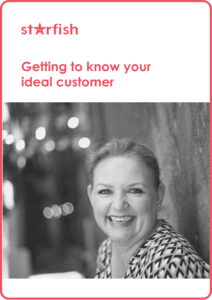Part 2 in describing your ideal customer takes you through the process in a bit more detail. If you have nailed describing your ideal customer by completing Part 1, simply watch the video to progress to the next module (Key Messages).
You may have more than one customer with similar traits and demographics. If so, you will need to write descriptions for each of the ideal customers you have identified. We recommend allowing about 30 minutes per ideal customer description to complete this step.
If you haven’t already done so, you can download the Course workbook in the Materials section. As additional support, there is also a completed example Workbook to use as a reference.
Note: you need to watch the video to be able to mark this module as complete and progress to the next module.
Video Transcript
Okay. So, if you’re watching this video, it means you’ve found it a little bit challenging to describe your ideal customer. So, in this video, we’ll just go through the process again, but with a little bit more detail to help you work through this.
I’d like to just reinforce, this is not easy to do. So, if you have been finding it challenging, that’s okay. That’s why we have marketers in the world to help you with this type of thing and it is something that does need to be learned. It doesn’t necessarily come naturally, and it’s okay to find this process challenging.
So, in saying that, hopefully, this a video will help make that process a little bit easier for you.
You can see on the screen here, we have a fleshed-out example of ideal customer one, which we’re using Starfish Marketing as.
The process to follow here is really go back through the different sections that you have already completed. So, go right back to the demographics, which is here, and always thinking about these top 10 or however many customers that you have put into your top 10, the most profitable, who you love working with. They’re always in mind because, at the end of the day, they’re your ideal customer and you want more people like that to be your ideal customer.
So, the first step is to go back to your demographics and look at ideal customer one and pull that detail through to the demographics section in the description of your ideal customer.
You can see here, I’ve actually identified with two different colourings, the two different ideal customers that we have.
So, we will go through and we’ll look at ideal customer one, populate the age, the marital status, children, that information then goes back down into your ideal customer section here in section one.
We’ll just skip through to the Starfish one, and as you can see, we’ve put the demographics detail in there.
Then, once you’ve got the demographics, we then look at the psychographics.
I find it easier to split the demographics and the psychographics because when you are crafting your marketing activities, they’re used for different purposes. So, your demographics may be used to identify, for example, some Facebook advertising. So, you will need that type of information to set your ad sets for your Facebook advertising. So, that’s one of the reasons we have those separated in this section here.
So then, the psychographics, and this is the more challenging piece.
With the psychographics we go back and, if you work with more than one screen, or maybe you could do a split-screen other than to-ing and fro-ing. You could copy and paste your psychographic information into a separate screen so you’re not scrolling back and forth. And you can have them side by side and then populate them that way. Or if you’re handwriting simply maybe photocopy a page or something like that.
So, we look at the values here.
Again, you can see I’ve highlighted the different ones. Our ideal customer one values are in pink and the ideal customer two values are in green. And where they crossed over I’ve just put them in twice and had the two different colours there. So, you look at those values and part of that process, in the what’s important to them, is potentially identifying the value. What does that mean in that? So, integrity. Well, doing what you say you will is important. Don’t do icky things.
So, this section here is what you pull through to your psychographic section in the description of your ideal client or your ideal customer. So, it shouldn’t necessarily be that different.
What you can do here is flesh it out a bit more. So, that is, with trust, once they trust someone they’re happy to hand over the responsibility. Following on from that, we know that the decisions that they make are based on emotion. So, the level of trust that they have with someone. If someone makes them feel icky, they’re not necessarily going to trust them and therefore, not going to be willing to hand over the work.
So, that’s an emotionally-based decision rather than say, a data-based decision.
So, if you think about that type of thing, what these values are and what the behaviour that value generates, that’s what goes into the psychographics.
So, when you then come to craft your key messages, which is in the next stage of the program, (you don’t need to populate this here, we take you through this in the next module). So, think about the psychographics and the behaviours that those values make happen, then that’s what goes into your psychographics there.
So, I hope that helps explain a little bit more how to describe your ideal customer.


